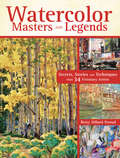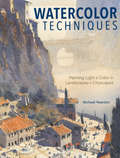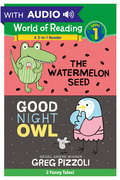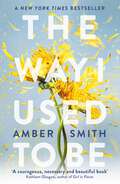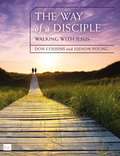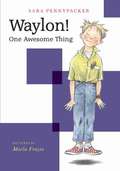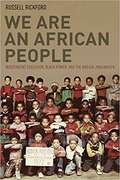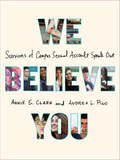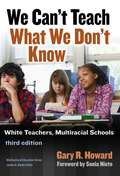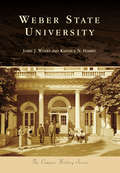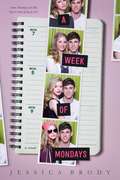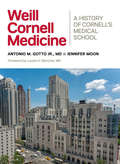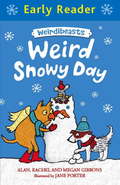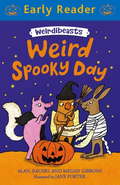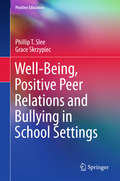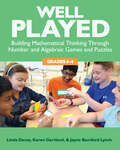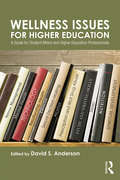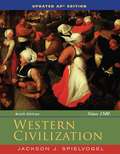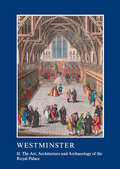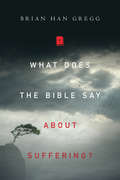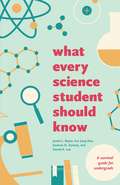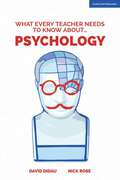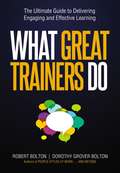- Table View
- List View
Watercolor Masters and Legends: Secrets, Stories and Techniques from 34 Visionary Artists
by Betsy Dillard StroudDiscover the secrets of watercolor mastery! Late 20th and 21st century watercolor artists have transformed the art of watermedia into a golden phenomenon and one of the most significant movements in the history of art. The lives and works of the 34 artists represented here display a multitude of different approaches, philosophies and techniques. Each has a unique perspective and an innovative approach; artists such as Ann Smith, Cheng-Kee Chee, John Salminen and many more share their secrets. You'll also get a behind-the-scenes look at legends like Robert E. Wood, Naomi Brotherton, Edgar A. Whitney and Ed Betts, whose teaching and work contributes invaluably to the aesthetics of the medium and their students.More than 125 pieces of exquisite art18 innovative demonstrations34 artist interviews and commentariesDiscover proud watercolor painting traditions, new perspectives on the medium, and works of art to influence new generations of artists. Get ready to be inspired with this one of a kind collection.
Watercolor Techniques: Painting Light and Color in Landscapes and Cityscapes
by Michael Reardon"No other medium is as magical and enjoyable as watercolor." So says artist and author Michael Reardon. In Watercolor Techniques: Painting Light and Color in Landscapes and Cityscapes, Reardon covers it all, from answers to beginners' most vexing problems (What is the proper ratio of pigment and water? How do I lay down an even wash? Why do my paintings look so washed out?) to understanding the trifecta of perspective, value, and color. He shows how to paint whites that sparkle and shadows that glow and how to conjure the atmosphere of a particular place and time. Painters of all skill levels will see--and feel--the difference in their work.Packed with expert advice for infusing scenes with light and colorIncludes special tips and techniques for painting architectural subjectsIllustrated with inspiring paintings of scenes from around the world8 start-to-finish demonstrations show key concepts in action"Light, as it glances off a facade, glimmers off the water or gleams off polished marble, is always inspiring. Color, with its infinite array of hues, is always irresistible. Searching for ways to make them harmonize and tell a story can last a lifetime."
Watermelon Seed, The and Good Night Owl 2-in-1 Listen-Along Reader: 2 Funny Tales with Audio! Level 1 (World of Reading (eBook))
by Greg PizzoliThis collection features two funny, award-winning tales by Greg Pizzoli-perfect for kids just learning to read!The Watermelon SeedOh no! I swallowed a seed!Join in the hysteria as this hilarious crocodile imagines the worst.Good Night OwlOwl is ready for bed. But as soon as he settles in, he hears a strange noise. He'll never get to sleep unless he can figure out what's going on!
The Way I Used to Be
by Amber SmithTHE TIKTOK SENSATION THAT EVERYONE IS TALKING ABOUT 'After finishing this book, my heart was pounding and I couldn&’t find words big enough to describe how brilliant, beautiful, and powerful it is.' L.E. Flynn, author of All Eyes On Her All Eden wants is to rewind the clock. To live that day again. She would do everything differently. Not laugh at his jokes or ignore the way he was looking at her that night. And she would definitely lock her bedroom door. But Eden can&’t turn back time. So she buries the truth, along with the girl she used to be. She pretends she doesn&’t need friends, doesn&’t need love, doesn&’t need justice. But as her world unravels, one thing becomes clear: the only person who can save Eden … is Eden.
The Way of a Disciple: Walking with Jesus
by Don Cousins Judson PolingThe Walking with God series was developed as the curriculum for small groups at Willow Creek Community Church in South Barrington, Illinois. Since its release in 1992, it has been used by churches and small groups to help raise up devoted disciples of Christ. Group members who work through the program will lay a solid foundation for a lifelong walk with God.While small groups may be formed for a variety of purposes, the goal of this curriculum is for groups to produce disciples—fully devoted followers of Christ—by studying God’s Word in community. <P><P> To this end, the goal of the study is to produce disciples who walk with God, have a personal relationship with Jesus, and live in step with the Holy Spirit. It is also to produce believers who live the Word in all areas of life and contribute to the work that God is doing in the local church. Ultimately, the goal is to develop believers who impact the world and are prepared and eager to spread the good news of Christ to others.This material will help develop these attributes in group members. Each lesson includes group Bible study and discussion questions in addition to devotions, reflections, and personal study for use by individuals between the group sessions.
Waylon! One Awesome Thing (Waylon! #1)
by Sara PennypackerFrom the creators of the New York Times bestselling series Clementine comes another chapter book collection that will keep readers engaged and laughing until the very last page.Waylon has lots of ideas for making life more awesome through science, like teleportation, human gills, and attracting cupcakes by controlling gravity. But it's impossible for him to concentrate on his inventions when he's experiencing his own personal Big Bang.Arlo Brody is dividing the fourth grade boys into two groups. Waylon would rather be friends with everyone. Well, everyone except the scary new kid, Baxter Boylen.Waylon's older sister, Neon, is shooting away from the family. He wishes everything would go back to the way it was before she started wearing all black and saying "What's the point?" all the time.Just when it looks as though Waylon's universe is exploding, something happens to bring it all together again, and it is, without a doubt, One Awesome Thing.
We Are An African People: Independent Education, Black Power, And The Radical Imagination
by Russell RickfordDuring the height of the Black Power movement of the late 1960s and 1970s, dozens of Pan African nationalist private schools, from preschools to post-secondary ventures, appeared in urban settings across the United States. The small, independent enterprises were often accused of teaching hate and were routinely harassed by authorities. Yet these institutions served as critical mechanisms for transmitting black consciousness. Founded by activist-intellectuals and other radicalized veterans of the civil rights movement, the schools strove not simply to bolster the academic skills and self-esteem of inner-city African-American youth but also to decolonize minds and foster a vigorous and regenerative sense of African identity. In We Are An African People, historian Russell Rickford traces the intellectual lives of these autonomous black institutions, established dedicated to pursuing the self-determination that the integrationist civil rights movement had failed to provide. Influenced by Third World theorists and anticolonial campaigns, organizers of the schools saw formal education as a means of creating a vanguard of young activists devoted to the struggle for black political sovereignty throughout the world. Most of the institutions were short-lived, and they offered only modest numbers of children a genuine alternative to substandard, inner-city public schools. Yet their stories reveal much about Pan Africanism as a social and intellectual movement and as a key part of an indigenous black nationalism. Rickford uses this largely forgotten movement to explore a particularly fertile period of political, cultural, and social revitalization that strove to revolutionize African American life and envision an alternate society. Reframing the post-civil rights era as a period of innovative organizing, he depicts the prelude to the modern Afrocentric movement and contributes to the ongoing conversation about urban educational reform, race, and identity.
We Believe You: Survivors of Campus Sexual Assault Speak Out
by Andrea L. Pino Annie E. Clark"Me too. It happened to me too." More than one in five women and 5 percent of men are sexually assaulted while at college. Some survivors are coming forward; others are not. In We Believe You, students from every kind of college and university--large and small, public and private, highly selective and less so--share experiences of trauma, healing, and everyday activism, representing a diversity of races, economic and family backgrounds, gender identities, immigration statuses, interests, capacities, and loves. Theirs is a bold, irrefutable sampling of voices and stories that should speak to all.
We Can't Teach What We Don't Know
by Gary R. Howard Sonia NietoFor author Gary Howard, the issues and passions that sparked the writing of the first edition of this now classic work are as intense today as they were then. In the Third Edition, Howard reviews the progress that has been made in the interim (for example, the first Black president in the White House), as well as the lack of progress (the gutting of the 1965 Voting Rights Act, the epidemic of Black youth killed by police, the persistence of race-based educational disparities). Making a case for the "fierce urgency of now" this new edition deepens the discussion of race and social justice in education with new and updated material. Aligned with the United States' ever more diverse student population, it speaks to what good teachers know, what they do, and how they embrace culturally responsive teaching. This essential text is widely used in teacher preparation courses and for in-service professional development. New for the third edition is: a revised introduction that places the book in the context of the 50th anniversay of the 1963 march on Washington; an updated analysis of White social dominance, bringing in the Critical Race Theory and reflecting on the racist reaction to the election of the first US Black President; more detail to the White Identity Orientations model; a new section "The Whiteness of School Reform", demonstrating how White social dominance drives much of the corporate school reform movement; a rich discussion of the seven principles for Culturally Responsive Teaching, and an expanded Reflection and Discussion Guide authored by two educators who have been using the book in professional development sessions for many years.
Weber State University (Campus History)
by Jamie J. Weeks Kandice N. HarrisNestled in the foothills of the beautiful Wasatch Mountains, Weber State University has been serving the Greater Weber and Davis County communities for over 125 years. On January 7, 1889, Weber Stake Academy opened its doors for the first time to approximately 100 students. The academy continued to grow and develop through five name changes and several relocations. Throughout this time, the institution survived many financial and political struggles. Today, the university has increased in size to accommodate over 26,000 students. This pictorial history was put together in commemoration of Weber's 125th anniversary, and it provides a compelling look into the struggles and ultimate survival of a historic academic institution.
A Week of Mondays
by Jessica BrodyWhen I made the wish, I just wanted a do-over. Another chance to make things right. I never, in a million years, thought it might actually come true... <P><P>Sixteen-year-old Ellison Sparks is having a serious case of the Mondays. She gets a ticket for running a red light, she manages to take the world’s worst school picture, she bombs softball try-outs and her class election speech (note to self: never trust a cheerleader when she swears there are no nuts in her bake-sale banana bread), and to top it all off, Tristan, her gorgeous rocker boyfriend suddenly dumps her. For no good reason! <P><P>As far as Mondays go, it doesn’t get much worse than this. And Ellie is positive that if she could just do it all over again, she would get it right. So when she wakes up the next morning to find she’s reliving the exact same day, she knows what she has to do: stop her boyfriend from breaking up with her. But it seems no matter how many do-overs she gets or how hard Ellie tries to repair her relationship, Tristan always seems bent set on ending it. Will Ellie ever figure out how to fix this broken day? Or will she be stuck in this nightmare of a Monday forever? <P><P>From the author of 52 Reasons to Hate My Father and The Unremembered trilogy comes a hilarious and heartwarming story about second (and third and fourth and fifth) chances. Because sometimes it takes a whole week of Mondays to figure out what you really want. <P><P>Lexile Measure: HL640L
Weill Cornell Medicine: A History of Cornell’s Medical School
by Antonio M. Gotto Jr. Jennifer Moon Laurie H. GlimcherWeill Cornell Medicine is a story of continuity and transformation. Throughout its colorful history, Cornell's medical school has been a leader in education, patient care, and research—from its founding as Cornell University Medical College in 1898, to its renaming as Weill Cornell Medical College in 1998, and now in its current incarnation as Weill Cornell Medicine. In this insightful and nuanced book, dean emeritus Antonio M. Gotto Jr., MD, and Jennifer Moon situate the history of Cornell's medical school in the context of the development of modern medicine and health care. The book examines the triumphs, struggles, and controversies the medical college has undergone. It recounts events surrounding the medical school’s beginnings as one of the first to accept female students, its pioneering efforts to provide health care to patients in the emerging middle class, wartime and the creation of overseas military hospitals, medical research ranging from the effects of alcohol during Prohibition to classified partnerships with the Central Intelligence Agency, and the impact of the Depression, 1960s counterculture, and the Vietnam War on the institution. The authors describe how the medical school built itself back up after nearing the brink of financial ruin in the late 1970s, with philanthropic support and a renewal of its longstanding commitments to biomedical innovation and discovery.Central to this story is the closely intertwined, and at times tumultuous, relationship between Weill Cornell and its hospital affiliate, now known as New York–Presbyterian. Today the medical school’s reach extends from its home base in Manhattan to a branch campus in Qatar and to partnerships with institutions in Houston, Tanzania, and Haiti. As Weill Cornell Medicine relates, the medical college has never been better poised to improve health around the globe than it is now.
Weird Snowy Day: Book 4 (Weirdibeasts #4)
by Alan Gibbons Megan Gibbons Rachel GibbonsA full colour blue Early Reader story from million-copy-selling author Alan Gibbons writing with his daughters, Megan and Rachel.Early Readers are stepping stones from picture books to reading books perfect for building confidence in new readers and reluctant readers. A blue Early Reader is perfect for sharing and reading together. A red Early Reader is the next step on your reading journey.Katie Cat saw it first. It was a single white flake drifting down from the sky. It's a snowy day, and that means snowball fights and playing outside with friends. Even the littlest animals can have fun in the snow.A delightful new Weirdibeasts story from million-copy-selling author Alan Gibbons writing with his daughters, Megan and Rachel, and illustrated by Jane Porter.
Weird Spooky Day: Book 3 (Weirdibeasts #3)
by Alan Gibbons Megan Gibbons Rachel GibbonsJoin the Weirdibeasts for Halloween in this brand-new full colour blue Early Reader story from million-copy-selling author Alan Gibbons writing with his daughters, Megan and Rachel.Early Readers are stepping stones from picture books to reading books perfect for building confidence in new readers and reluctant readers. A blue Early Reader is perfect for sharing and reading together. A red Early Reader is the next step on your reading journey.It's the weirdest Halloween ever. Mrs Creature is having a Halloween party, with food, games and a special prize for the best fancy dress. The Weirdibeasts can't wait to try on their scary costumes and dress up. A fun Halloween-inspired story from Alan Gibbons, writing with his daughters, Megan and Rachel, and illustrated by Jane Porter.
Well-Being, Positive Peer Relations and Bullying in School Settings
by Phillip T. Slee Grace SkrzypiecThis book focuses on well-being at school in association with positive peer relationships and bullying. Taking an integrative and community-based approach, the book outlines the significance of student-school relationships for well-being and emphasizes the importance of school and classroom climate for promoting well-being. Embedded in research and theory, the book reflects the belief that all of our dealings with children and young people in whatever role, whether as parent or teacher or in some other capacity, are bounded by theory, either implicit or explicit. The book highlights the role of partnerships and linkages in addressing school-based well-being and anti-bullying programs. It pays special attention to the barriers and facilitators that schools must address in engaging with external agencies to deliver strong evidence-based initiatives. The international concern with school bullying is given particular consideration in relation to its impact on the well-being of all involved. A feature of the text is the focus given to the implementation of programs into the busy and complex world of schools and classrooms recognizing that the effectiveness and impact of any school-based program is strongly related to the quality of its implementation. The text reflects a commitment of the authors to a broad-based systemic view of development, taking into account family, school, community and culture as influential factors. The text incorporates a number of pedagogical features e. g. classroom based activities and discussion starters, reflections on points raised in the text, and case studies. This book is of special interest to teachers, school counselors, educational psychologists and mental health professionals working in school settings.
Well Played, Grades 6-8: Building Mathematical Thinking Through Number and Algebraic Games and Puzzles
by Linda Dacey Karen Gartland Jayne Bamford LynchStudents love math games and puzzles, but how much are they really learning from the experience? Too often, math games are thought of as just a fun activity or enrichment opportunity. Well Played, Grades 6-8: Building Mathematical Thinking Through Number and Algebraic Games and Puzzles shows you how to make games and puzzles an integral learning component that provides teachers with unique access to student thinking. This third book in the series helps you engage students in grades 6-8 in discussions of mathematical ideas and deepen their conceptual understanding. It also helps you develop students' fluency with number systems; ratio and proportional relationships; expressions and equations, statistics and probability; and patterns, graphs, and functions. The twenty-five games and puzzles in Well Played, Grades 6-8 which have all been field-tested in diverse classrooms, contain: Explanations of the mathematical importance of each game or puzzle and how it supports student learning. Variations for each game or puzzle to address a range of learning levels and styles Classroom vignettes that model how best to introduce the featured game or puzzle. The book also includes a separate chapter with suggestions for how to effectively manage games and puzzles in diverse classrooms; game boards, game cards, and puzzles; assessment ideas; and suggestions for online games, puzzles, and apps. Well Played, Grades 6-8 will help you tap the power of games and puzzles to engage students in sustained and productive mathematical thinking.
Wellness Issues for Higher Education: A Guide for Student Affairs and Higher Education Professionals
by David S. AndersonWellness Issues for Higher Education is an essential resource that addresses a range of student wellness issues confronting professionals in college and university settings. Organized around five dimensions of Wellness—Emotional, Social, Intellectual, Physical, and Spiritual—this book comprehensively covers key topics that contribute to students’ success in college. Each topical chapter includes proactive wellness advice, and is designed to prepare the reader to better understand the facts, issues, and strategies appropriate for addressing the issue. Each Chapter Features: Background information, theory, and research Historical and emerging issues Common questions, controversies, challenging situations, and misconceptions Practical applications for the campus This practical guide prepares practitioners to understand and deal with the wellness and health promotion issues contributing to their students’ overall success and well-being. Armed with this valuable resource, higher education and student affairs professionals can work to improve academic performance, retention, satisfaction, and quality of life. This thorough resource will guide those working at any level in residence life, student activities, orientation, health education, student leadership, advising, instruction, and other areas of student development.
Western Civilization: Since 1300 (Ninth Edition) (Updated AP® Edition)
by Jackson J. SpielvogelThis book is a useful instrument for introducing students to the history of Western civilization.
WESTERN POLITICAL THOUGHT, M.A.Politics (Previous) Paper–II, SDE Andhra University
by Dr A Venkata Rao Dr K. Ramachandra Murthy Dr S Subba Rao Prof Ps Reddy Bvv BalakrishnaThis is the prescribed text book for students pursuing MA Politics Previous Paper 2 - Western Political Thought through school of distance education, Andhra University
Westminster Part II: The Art, Architecture and Archaeology of the Royal Palace (The British Archaeological Association Conference Transactions)
by Warwick Rodwell; Tim Tatton-BrownWestminster came into existence in the later Anglo-Saxon period, and by the mid-11th century, when Edward the Confessor’s great new abbey was built, it was a major royal centre two miles south-west of the City of London. Within a century or so, it had become the principal seat of government in England, and this series of twenty-eight papers covers new research on the topography, buildings, art-history, architecture and archaeology of Westminster’s two great establishments — Abbey and Palace. Part I begins with studies of the topography of the area, an account of its Roman-period finds and an historiographical overview of the archaeology of the Abbey. Edward the Confessor’s enigmatic church plan is discussed and the evidence for later Romanesque structures is assembled for the first time. Five papers examine aspects of Henry III’s vast new Abbey church and its decoration. A further four cover aspects of the later medieval period, coronation, and Sir George Gilbert Scott’s impact as the Abbey’s greatest Surveyor of the Fabric. A pair of papers examines the development of the northern precinct of the Abbey, around St Margaret’s Church, and the remarkable buildings of Westminster School, created within the remains of the monastery in the 17th and 18th centuries. Part II part deals with the Palace of Westminster and its wider topography between the late 11th century and the devastating fire of 1834 that largely destroyed the medieval palace. William Rufus’s enormous hall and its famous roofs are completely reassessed, and comparisons discussed between this structure and the great hall at Caen. Other essays reconsider Henry III’s palace, St Stephen’s chapel, the king’s great chamber (the ‘Painted Chamber’) and the enigmatic Jewel Tower. The final papers examine the meeting places of Parliament and the living accommodation of the MPs who attended it, the topography of the Palace between the Reformation and the fire of 1834, and the building of the New Palace which is better known today as the Houses of Parliament.
What Does the Bible Say About Suffering?
by Brian Han GreggWhat Does the Bible Say About Suffering?
What Every Science Student Should Know (Chicago Guides to Academic Life)
by Justin L. Bauer Andrew H. Zureick Yoo Jung Kim Daniel K. Lee"I am often amazed at how much more capability and enthusiasm for science there is among elementary school youngsters than among college students. . . . We must understand and circumvent this dangerous discouragement. No one can predict where the future leaders of science will come from."--Carl Sagan In 2012, the White House put out a call to increase the number of STEM graduates by one million. Since then, hundreds of thousands of science students have started down the path toward a STEM career. Yet, of these budding scientists, more than half of all college students planning to study science or medicine leave the field during their academic careers. What Every Science Student Should Know is the perfect personal mentor for any aspiring scientist. Like an experienced lab partner or frank advisor, the book points out the pitfalls while providing encouragement. Chapters cover the entire college experience, including choosing a major, mastering study skills, doing scientific research, finding a job, and, most important, how to foster and keep a love of science. This guide is a distillation of the authors' own experiences as recent science graduates, bolstered by years of research and interviews with successful scientists and other science students. The authorial team includes former editors-in-chief of the prestigious Dartmouth Undergraduate Journal of Science. All have weathered the ups and downs of undergrad life--and all are still pursuing STEM careers. Forthright and empowering, What Every Science Student Should Know is brimming with insider advice on how to excel as both a student and a scientist.
What Every Teacher Needs to Know about Psychology
by David Didau Nick RoseMuch of what we do in classrooms is intuitive, steered by what 'feels right', but all too often intuition proves a poor, sometimes treacherous guide. Although what we know about the workings of the human brain is still pitifully little, the science of psychology can and has revealed certain surprising findings that teachers would do well to heed. Over the past few decades, psychological research has made real strides into understanding how we learn, but it's only in the last few years that education has become aware of these insights. Part of the problem is a tendency amongst teachers to resist being told 'what works' if it conflicts with intuition. Whilst we cannot and should not relinquish our professional judgement in the face of outlandish claims, we should at least be aware of what scientists have discovered about learning, thinking, motivation, behaviour and assessment over the past few decades. This though is far easier said than done. Every year thousands of research papers are published, some of which contradict each other. How can busy teachers know which research is worth investing time in reading and understanding? Here, David Didau and Nick Rose attempt to lay out the evidence and theoretical perspectives on what they believe are the most important and useful psychological principles of which teachers ought to be aware. That is not to say this book contains everything you might ever need to know - there is no way it could - it is merely a primer. We hope that you are inspired to read and explore some of the sources for yourself and see what other principles can find a home in your classroom. Some of what we present may be surprising, some dubious, but some in danger of being dismissed as 'blindingly obvious'. Before embracing or dismissing any of these principles we urge you to interrogate the evidence and think carefully about the advice we offer. While nothing works everywhere and everything might work somewhere, this is a guide to what we consider the best bets from the realm of psychology.
What Every Teacher Needs to Know about Psychology
by David Didau Nick RoseMuch of what we do in classrooms is intuitive, steered by what 'feels right', but all too often intuition proves a poor, sometimes treacherous guide. Although what we know about the workings of the human brain is still pitifully little, the science of psychology can and has revealed certain surprising findings that teachers would do well to heed. Over the past few decades, psychological research has made real strides into understanding how we learn, but it's only in the last few years that education has become aware of these insights. Part of the problem is a tendency amongst teachers to resist being told 'what works' if it conflicts with intuition. Whilst we cannot and should not relinquish our professional judgement in the face of outlandish claims, we should at least be aware of what scientists have discovered about learning, thinking, motivation, behaviour and assessment over the past few decades. This though is far easier said than done. Every year thousands of research papers are published, some of which contradict each other. How can busy teachers know which research is worth investing time in reading and understanding? Here, David Didau and Nick Rose attempt to lay out the evidence and theoretical perspectives on what they believe are the most important and useful psychological principles of which teachers ought to be aware. That is not to say this book contains everything you might ever need to know - there is no way it could - it is merely a primer. We hope that you are inspired to read and explore some of the sources for yourself and see what other principles can find a home in your classroom. Some of what we present may be surprising, some dubious, but some in danger of being dismissed as 'blindingly obvious'. Before embracing or dismissing any of these principles we urge you to interrogate the evidence and think carefully about the advice we offer. While nothing works everywhere and everything might work somewhere, this is a guide to what we consider the best bets from the realm of psychology.
What Great Trainers Do: The Ultimate Guide to Delivering Engaging and Effective Learning
by Robert BoltonCorporate trainers are tasked with an awesome responsibility--helping individuals develop the skills they need to advance their careers and boost their organizations' bottom lines. It's a challenging job, but What Great Trainers Do is here to help--providing a proven structure for dynamic workshops along with surefire strategies for blending course content with fluid interaction. Readers will learn how to: Organize presentations for maximum impact Use activities to connect participants to the content and each other Create visual aids that reinforce key points Fine-tune their delivery Listen actively and read the group Address questions and concerns Make presentations interactive--involving learners early and often Manage the tough moments Handle resistance Use debriefs, demonstrations, and deliberate practice to solidify performance, improve applicability, and make training stick Adapt the course to fit the participants Promote positive group process And much more Great training doesn't happen by accident. Accessible and practical, What Great Trainers Do is a one-stop resource for reliable, repeatable learning results.
